10 Companion Plants for Okra (With Pictures)
-
Pete Ortiz
- Last updated:
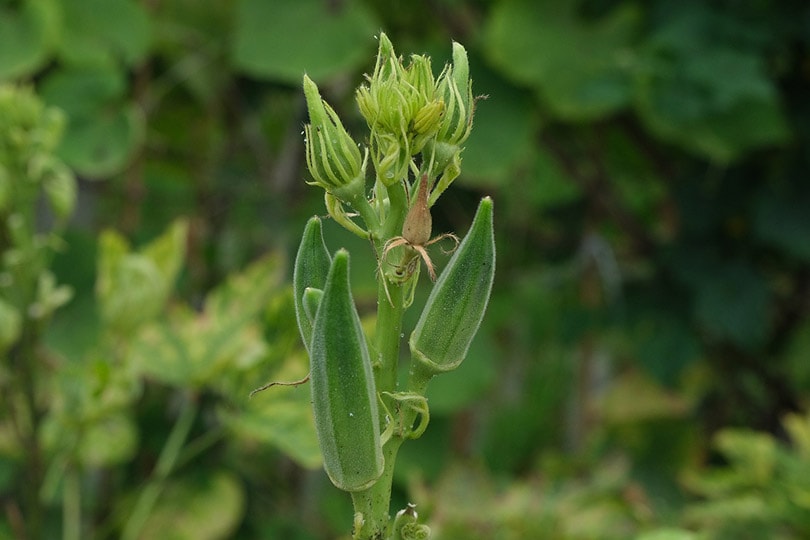
Companion planting can enhance the flavor and give you a bumper harvest from your crops. It can also help you fight pests and diseases that may attack your crops in the garden. Okra is among the plants that benefit a lot from companion planting.
Okra can be a prolific plant that can overtake your vegetable garden. So, you must be intentional about where you plant it. Don’t worry about that just yet. The best companion plants for okra will ease your mind and worries, so get planting!
What Is Okra?
This edible plant belongs to the mallow family. It produces fruits that look like small inflated pods with pointed tips. The pods are green when young but turn yellow or white when they ripen and soften. The plant can grow up to four feet tall, producing large leaves at the base that form a rosette shape around the stem. Usually, the stems are green but can also be purple or red. It depends on the okra variety you’re growing.
The fruit inside each pod contains many seeds surrounded by a mucilaginous gel. It’s a thickening agent in soups and stews worldwide (especially in Africa). Besides its culinary uses, okra also has medicinal properties. Traditional healers across Africa have used okra for centuries to treat various ailments.
The Top 10 Companion Plants for Okra
1. Sunflower
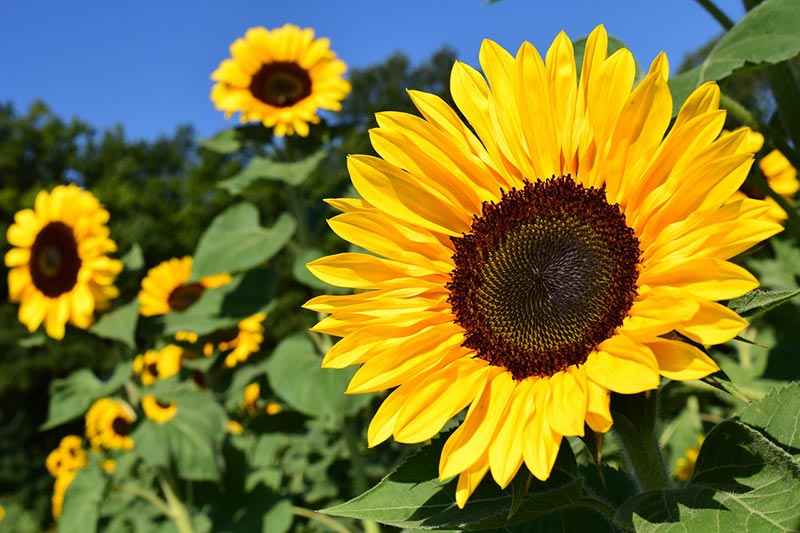
| Soil Type: | Many types of soil |
| Soil pH: | Between 6.0 and 7.5 (slightly acidic to a bit alkaline) |
| Sunlight Exposure: | Full sun |
| Watering Requirements: | One inch of water every week during the entire growing season |
Sunflower is an annual plant grown for its edible seeds and attractive flowers. It grows well with okra, attracting pollinators such as bees and butterflies. It increases the likelihood of successful pollination in okra flowers. The plant’s tall growth also protects okra from the wind.
The best way to plant sunflowers alongside okra is along the edges or border of your okra garden.
2. Radish
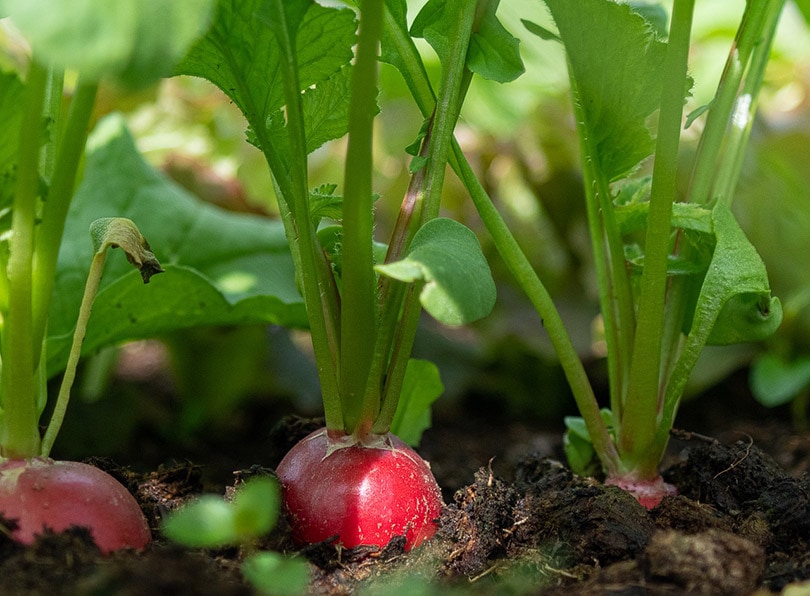
| Soil Type: | Well-drained sandy soil |
| Soil pH: | 0 to 7.0 |
| Sunlight Exposure: | Full sun, tolerates partial shade |
| Watering Requirements: | An inch of water per week |
Radish is in the Brassicaceae family. They’re an excellent companion plant for okra because they help break up the soil for better drainage. Radishes also prevent root diseases.
When planted alongside okra, as they help suppress weeds and improve soil quality. When you harvest the radishes, add them to your compost pile. They will break down organic matter and return nutrients to the soil. Okra needs these nutrients to thrive.
3. Cucumber

| Soil Type: | Well-drained, loose soil with organic matter and enough plant nutrients |
| Soil pH: | Between 6.0 and 6.5 |
| Sunlight Exposure: | Six to eight hours of direct sunlight every day |
| Watering Requirements: | One inch of water each week |
Cucumbers are another warm-weather vegetable that can grow alongside okra. The two plants need similar growing conditions. One of the best things about growing them together is that they need little maintenance. They also don’t need much fertilizing or watering once established in your garden.
However, take note to plant them too close to each other. Cucumbers need full sun, and the okra plants may shade them. It’s best to plant them six inches apart.
4. Pepper
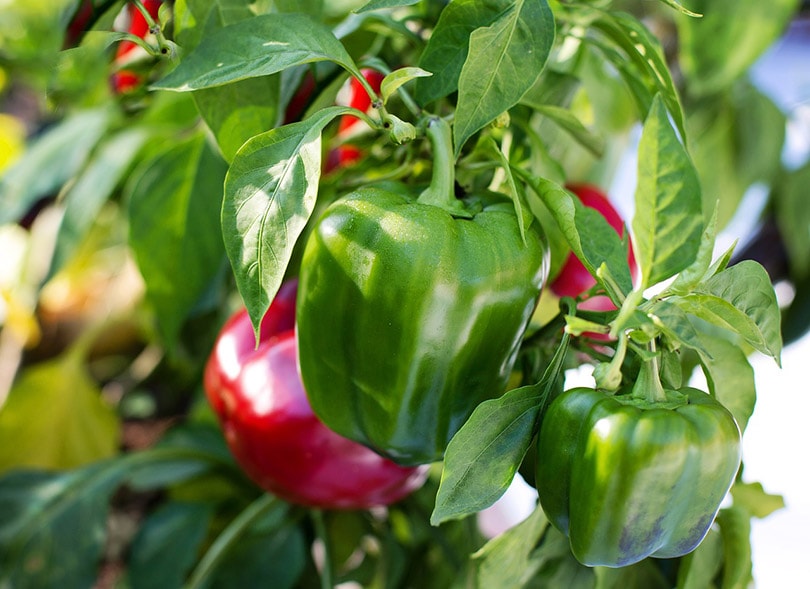
| Soil Type: | Deep, rich, loamy soil |
| Soil pH: | Between 6.5 and 7.0 |
| Sunlight Exposure: | Six to eight hours daily |
| Watering Requirements: | Around one to two inches weekly |
Pairing peppers with other plants is challenging. It’s because they need a lot of nitrogen. But they’re excellent companion plants for okra. They deter pests like beetles, aphids, and stink bugs.
They can also discourage cabbage worms that feed on young okra foliage. Only plant pepper close to okra if your okra plants are infested with cabbage worms.
You will need to plant pepper seeds along with your okra seeds. Besides, you can transplant pepper seedlings into the same area as your okra seedlings when they are about four inches tall.
5. Eggplants
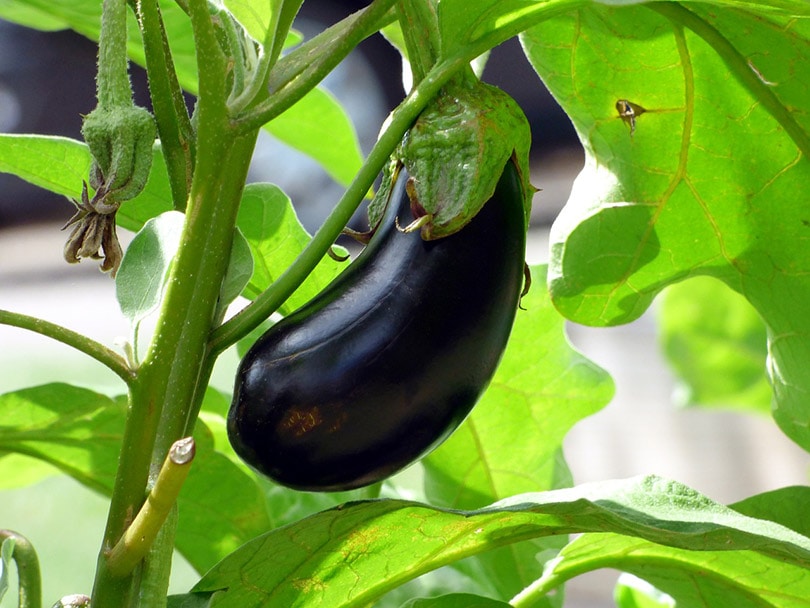
| Soil Type: | Well-draining, sandy loam high in organic matter |
| Soil pH: | Between 5.5 and 7.5 |
| Sunlight Exposure: | Full sun, between 6 and 8 hours daily |
| Watering Requirements: | One inch of water weekly or two inches during hot summers |
Eggplants are one of the easiest vegetables to grow. They thrive in hot weather and produce many fruits per plant. You can harvest eggplants when small or leave them to mature into large fruits.
Eggplants do better when planted close to okra. They exchange nutrients with each other.
So, position them next to each other on the garden bed rather than spreading them out over several rows. Planting these two plants together will help them thrive better than if you plant them alone.
6. Basil

| Soil Type: | Compost or organic matter-rich soil |
| Soil pH: | 0 to 7.0 |
| Sunlight Exposure: | Six to eight hours daily |
| Watering Requirements: | One inch weekly to keep the soil evenly moist |
Basil is an easy-to-grow herb that you can plant near any other plant. It has many uses, including making pesto sauce and adding flavor to salads. You can also use it as a garnish on dishes like spaghetti sauce or soups.
It’s a good companion plant for okra. It will repel pests such as whiteflies, aphids, and beetles, with its strong aroma. This aroma also attracts beneficial insects that keep pests away from your vegetables. Okra, in turn, can grow tall, giving shade to basils during hot weather.
7. Melons
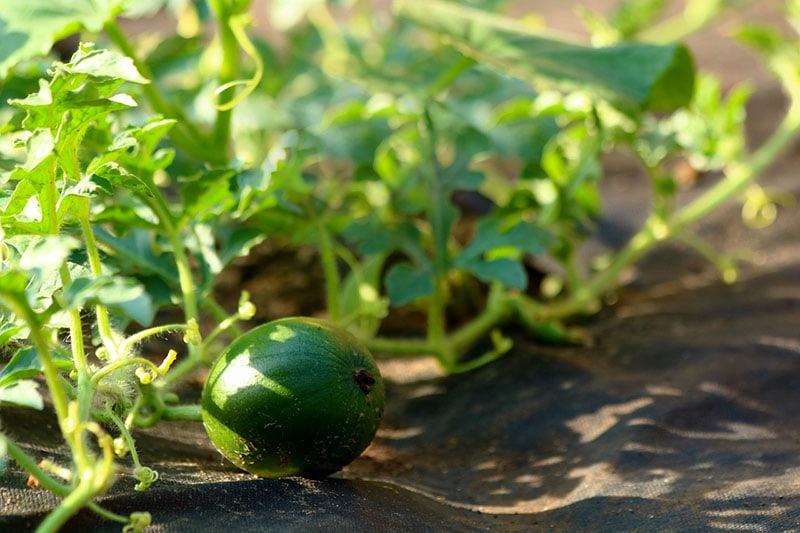
| Soil Type: | Well-draining, sandy loam soil |
| Soil pH: | Between 6.0 and 6.5 |
| Sunlight Exposure: | Full sun, eight to ten hours per day |
| Watering Requirements: | One to two inches weekly |
The melon vines keep the ground moist around your okra plants. Okra plants being tall, will provide shade to melon vines in return. Make sure melons aren’t shaded from the morning sunlight. The best way to do this is to plant melons on the eastern side of okra.
When planting melons with okra, there should be enough spacing at least three feet apart. It’s because melons need a lot of water and sunlight and can compete for these essential growth conditions if you plant them too close to each other. The vines too need space to grow. So, ensure you give them enough room.
8. Peas
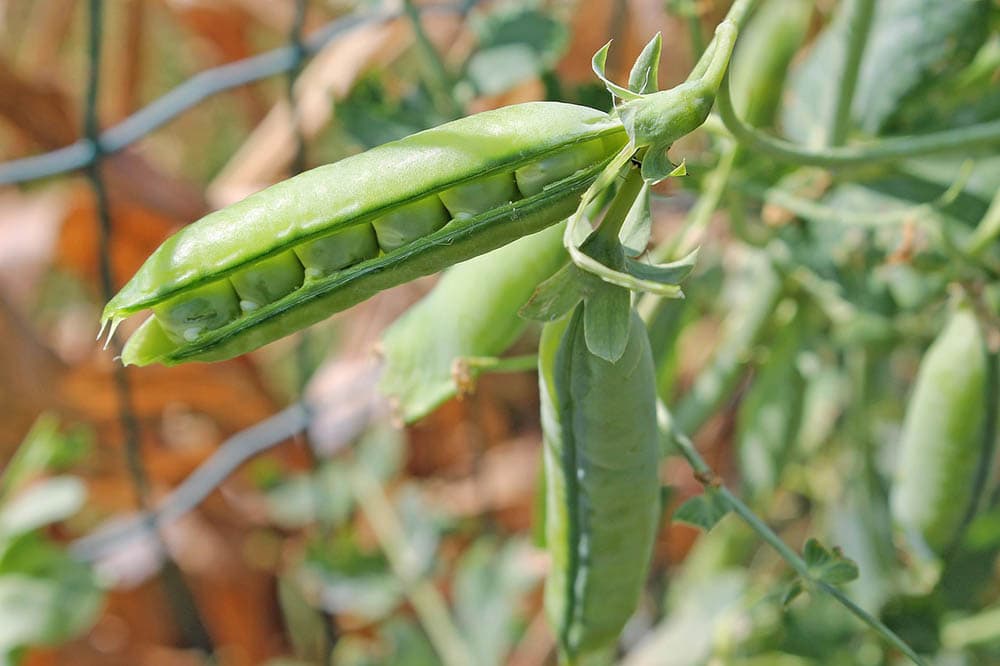
| Soil Type: | Well-drained sandy loam |
| Soil pH: | Between 5.5 and 6.5 |
| Sunlight Exposure: | Six to eight hours of direct sunlight every day |
| Watering Requirements: | No watering (annual rainfall of between 300 and 700 mm) |
Peas are legume plants that fix nitrogen in the soil and improve the soil structure. They convert nitrogen from the air into a form other plants can use. Okra also uses this nitrogen to grow. The flowers of peas also attract pollinators. Peas don’t compete for nutrients or water with okra, and they don’t take up a lot of space in the garden.
To begin with, plant peas in the garden. Later, plant your okra plants. This way, the okra seedlings won’t overcrowd your peas. Besides, you’ll harvest peas before your okra matures to take up more space in your garden.
9. Lettuce
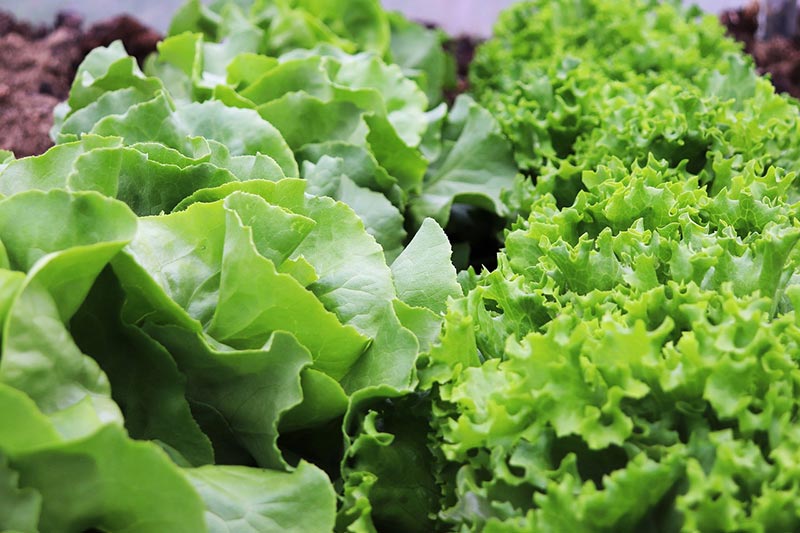
| Soil Type: | Fertile and well-drained moist soil |
| Soil pH: | Between 6.0 and 7.0 |
| Sunlight Exposure: | Full sun or partial shade |
| Watering Requirements: | Twice weekly (water when the soil is dry up to one inch deep) |
Lettuce is another easy-to-grow vegetable. It does well alongside okra plants because both prefer warmer temperatures. You can even harvest them simultaneously by picking lettuce leaves off as needed. Then, allow okra pods to mature on the vine until they are ready for harvest.
Lettuce helps control weeds at the base of your okra plants. In return, okra shades lettuce from the hot sun. Okra can reach a height of up to six feet.
Lettuce is fast-growing and can be harvested within a few weeks or less.
10. Calendula
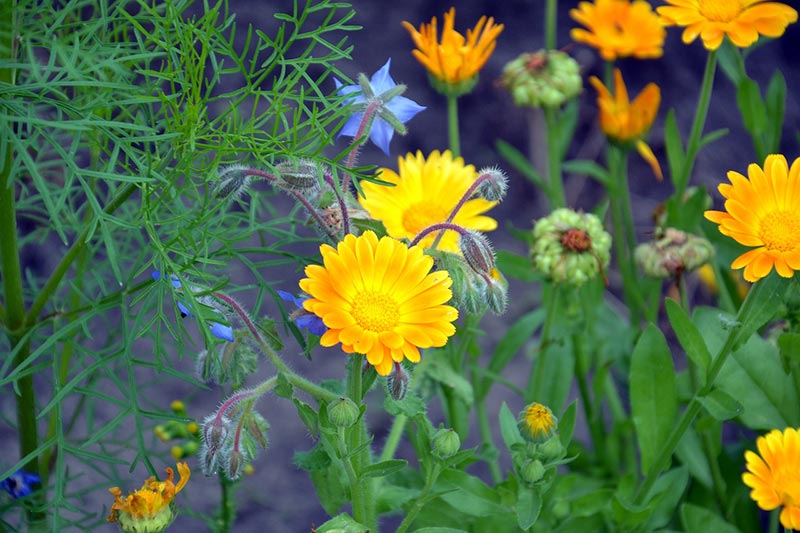
| Soil Type: | Well-draining soil with high organic matter content |
| Soil pH: | 6 to 7 |
| Sunlight Exposure: | Full sun |
| Watering Requirements: | 1 to 1 ½-inch of water once a week |
Calendula (pot marigold) is a perennial flower with many culinary uses and medicinal benefits. You can grow it as an annual or biennial depending on your climate zone. It’s a beautiful flower you can use as a companion plant for okra.
It has bright yellow flowers that attract beneficial insects like hoverflies and lacewings. These insects keep pests away from your vegetable garden. They also help in the pollination of your crops.
Okra and calendula also share many growing requirements. So, they will do well when planted together in your garden or backyard.
The 3 Worst Companion Plants for Okra
You’ve gone through some of the best companion plants and chosen a few to go with okra plants in your garden. Let’s look at a few plants you should keep off your okra garden.
1. Squash
Okra is a close relative of squash, so they share many common pests. These pests may spread to your okra if not controlled. Squash also attracts nematodes. Nematodes are destructive to okra.
2. Sweet potatoes
They grow well in warm climates. Their vines keep down the weeds in between rows of plants, but they’re not beneficial to okra as they also attract nematodes (tiny insects) harmful to okra. Nematodes in the soil can help several garden crops, but not okra.
3. Onions and garlic
The worst companion plants for okra include garlic and onions, which are members of the Allium family. They’re related to leeks and chives. These plants will make your okra plants taste bitter if planted near them. The best way to avoid this is planting your okra away from any Allium species.
The Benefits of Companion Planting
- Support: Companion plants can provide support for other plants. For example, you can plant peas with corn. Peas will climb onto corn using their trellis for support.
- Beneficial insects: Planting several plant species together attracts beneficial insects like bees. These insects will help pollinate your other plants!
- Shelter: Some plants provide shelter for others during harsh weather conditions. They may provide a windbreak or shade tree canopy to other plants.
- Soil improvement: Many plants help improve soil quality by adding nutrients and organic matter. The best example is legumes. Legumes come with root nodules that house bacteria. They convert nitrogen from the air into a beneficial form that plants can use.
- Decoy plants: Several plants give off smells. They help in covering up the odors of insect-desirable vegetables. The repellant effect is more pronounced when the two plants are grown close together, but it can extend over several feet. Sometimes, these odors attract beneficial insects that feed on crop pests.
Conclusion
If you want to grow okra, you must use companion plants that will complement its capabilities. Okra plants are amiable and need little care. They also depend on other food sources to thrive and reward their gardeners with an ample harvest of tasty pods.
These ten plants mentioned can improve and enrich the okra plant’s growth. They’ll also protect the plant from harmful insects and plant diseases.
See also: 23 Companion Plants for Eggplants (With Pictures)
Featured Image Credit: Elouis73, Pixabay
Contents



